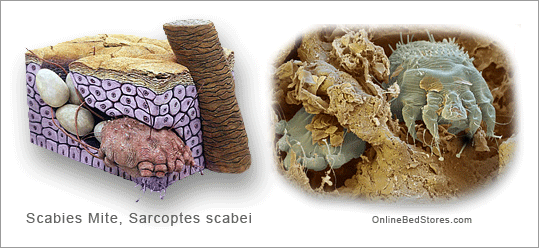Mites are members of the arachnid family and considered parasites, there are a variety of these parasitic mites known to bite humans and cause irritation, itchy papules and rashes. Scabies mites cause intense itching and are deep seated. These tiny mites will burrow into the skin to live and deposit eggs, causing inflammation of the skin and in some cases hair loss. The symptoms of scabies are due to an allergic reaction to the mites.
Scabies is most often spread during a relatively long period of direct skin contact with an infected person (at least 10 minutes) such as that which may occur during intimacy or living together. Spread of disease may occur even if the person has not developed symptoms yet. Crowded living conditions, such as those found in child-care facilities, group homes, and prisons, increase the risk of spread. People with a poor or weak immune system are those most likely to contract scabies during brief contact or by contaminated objects. The mite is very small and usually not directly visible. Diagnosis is based on the signs and symptoms.

Parasitic mites, like other insects, have a hard shell exoskeleton made of non-living material that does not grow in size with the insect’s development. Therefore, it is necessary for all insects to shed their exoskeletons several times during the course of their life. They accomplish this by using enzymes they create naturally to split open their exoskeleton and thus grow larger. It is during this molting phase that an insect is at its most vulnerable – susceptible to drying out or drowning since the hard shell that normally would protect them has been cast off.
The surface of every insect’s exoskeleton is covered with a waxy, water-repellant patina known as the cuticle. This outer coating protects the insect from harm, and has long been an obstacle for pesticide’s effectiveness – the chemicals must penetrate the cuticle in order to affect the insect, so pesticides employ a variety of volatile solvents, toxic dusts or light oils in order to cut through the cuticle and thus deliver the poison into the insect interior.
The solution to cracking the cuticle of an insect’s exoskeleton was discovered through the observation of insect entomology – insects employ enzymes to escape their exoskeletons. By utilizing cultured enzymes that mimic those found in nature, a natural form of biological pesticide can be produced that has the ability to dismantle the armor of an insect instantly.
Enzymes digests insect’s waxy cuticle on contact and dismantles their exoskeleton – effectively forcing insects into immediate molting in which the protective shell is stripped.
Using enzyme-based formulas as a form of biological pest control is an ingenious play of engaging the forces of nature to our advantage. Enzymes exist throughout the insect, plant and animal kingdoms to aid in the digestion of organic matter. Arachnids such as spiders and scorpions inject their prey with enzyme; insect larvae (maggots) also rely on enzymes to predigest their food for them. Insectivore plants also use enzymes to digest insect prey.
Unlike pesticides, enzyme control will never become obsolete. Because the biology of insects depends on the creation of enzymes in order for survival, it is impossible for insects to develop a resistance to enzymes as a method of pest control. Insects have an ability to rapidly evolve an immunity or resistance to commercial pesticides within a short time, even within a single crop cycle! This leads to a costly rotation of chemical warfare. Sadly, human beings do not have the biological tolerance to the persistent pollution of pesticides that insects do, and are often the ultimate victims of pesticide. Fortunately a consistently reliable and safe solution to pest control has been discovered – organic enzymes.

